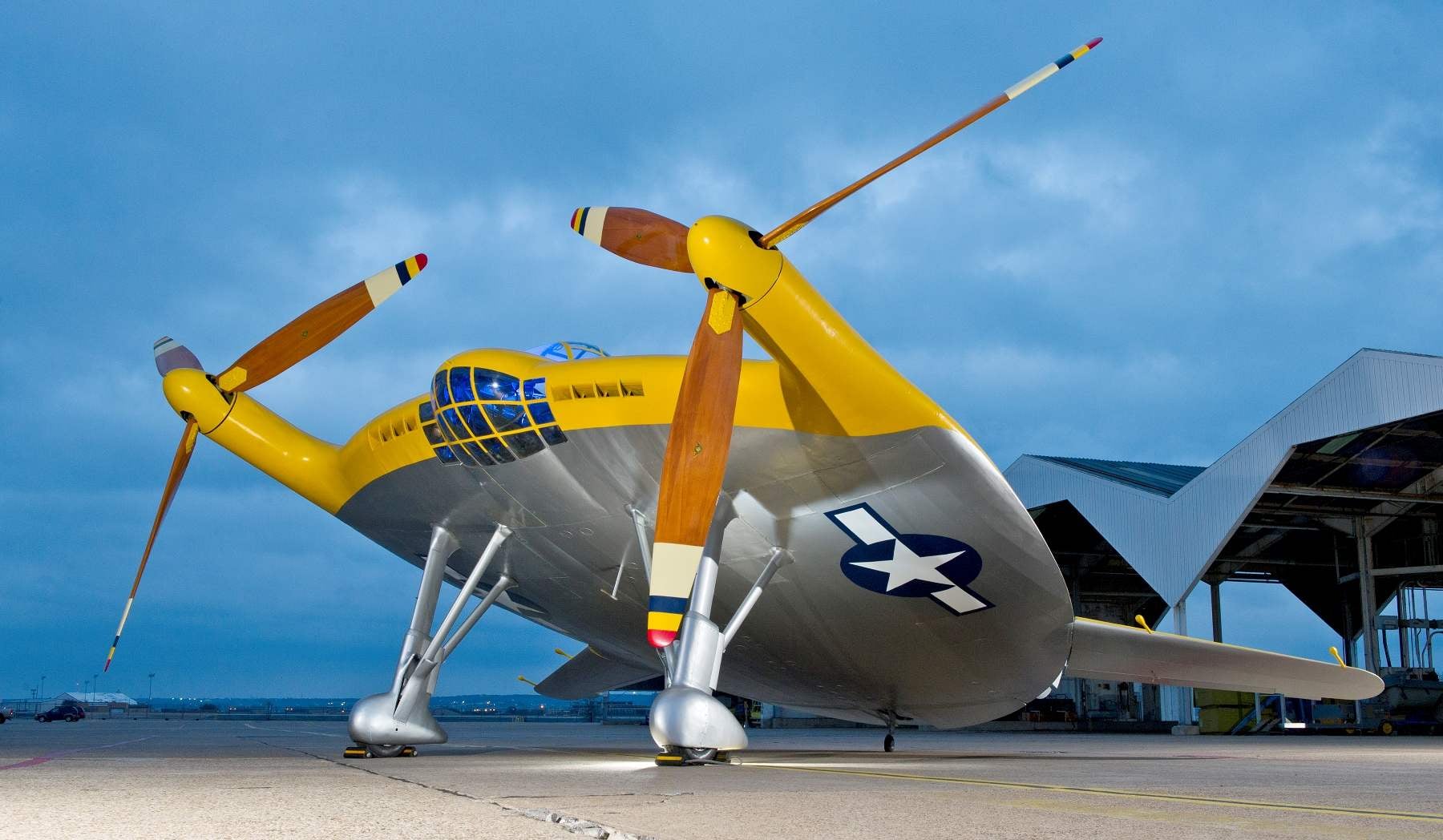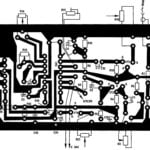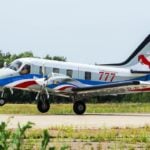 The experimental carrier-based fighter XF5U-1. In the 1940s, the American engineer Charles Zimmerman has created a unique aircraft aerodynamic configuration, which still continues to surprise not only for its unusual appearance, but also performance For their unique appearance, he has received numerous nicknames, among them such as “Flying parachute”, the “Flying pancake” and “Skimmer Zimmerman” Modern historians of aviation klassificeret this aircraft as the first fighter short takeoff and landing.
The experimental carrier-based fighter XF5U-1. In the 1940s, the American engineer Charles Zimmerman has created a unique aircraft aerodynamic configuration, which still continues to surprise not only for its unusual appearance, but also performance For their unique appearance, he has received numerous nicknames, among them such as “Flying parachute”, the “Flying pancake” and “Skimmer Zimmerman” Modern historians of aviation klassificeret this aircraft as the first fighter short takeoff and landing.
In 1930, H. Zimmerman graduated from the University of Kansas with a bachelor’s degree in electrical engineering. In the process of learning he attended a course of Aeronautics, which allowed him to get on the national Advisory Committee for Aeronautics (PASA) in Langley the Participation of young scientist in the development and manufacture of parachutes and daphnaida his work on improving wind tunnel — all this made his name known in the circle of aviation professionals.
In 1933, H Zimmerman, the former in the course of all the public works carried out in NACA, decided to try himself as an aircraft designer. For a start, he took part in the competition for civil pegki sampet. Proposed triple aircraft with an elliptical wing of small aspect ratio had two air-screws of large diameter on the wing tips, rotating in opposite directions to compensate for their torque. The direction of rotation of the screws was chosen such that the vortices formed by them compensated for those that went from the wing tips — this impeded the flow of air through the fins which, according to the calculations of H Zimmerman, increased aerodynamic efficiency of the apparatus as much as four times.
Initially, the propellers rotate independently, each from its engine. However, to improve the reliability of H Zimmerman mechanically linked them by a long horizontal shaft — this allows the aircraft when one of the engines to make a safe landing. To reduce drag the designer has placed the pilot and passengers lying on her stomach. Calculations have shown that such aircraft can have a high speed and high range.

V-173 in flight
A clear superiority in flight characteristics of the aircraft H Zimmerman over its competitors, however, did not prevent the NACA to reject the project as unwieldy and overly avant-garde for its time. Besides lying position of the passengers and the pilot was deemed not ergonomic. The winner of the contest became a classic cantilever monoplane Model 415-C Ercoupe company.
Having been refused, H Zimmerman was not satisfied and continued to improve your diskoplan. He was able to recruit two employees PASS by Richard Noyes and John Mackeeper. In 1934 they produced a few purge patterns to determine the flight characteristics of the aircraft. After successful tests in the wind tunnel action group has designed a radio-controlled flying model with a wingspan of 2.1 m, equipping her two French piston engines by cleone capacity of 25 HP, a rotating two-bladed propellers of large diameter.
The first trial runs of the engines showed that the device suffers from severe vibration screws. All further attempts to synchronize the rotation and eliminate vibration were unsuccessful. Testing had to stop, In order to prove the viability of their devices, in 1936, H Zimmerman made several rezinomotornaya models with a half-meter wingspan. Their successful flight was shot on film and was shown at NACA, with the purpose of obtaining money for continued work, however, its leaders, few believe in the idea of Zimmermann suggested him to look for an investor in the military or private aviation firms
At this time the film was read by the President of the Corporation United Aircraft Corporation Eugene Wilson. He became interested in unusual ideas H Zimmerman, and in 1937 the designer, who by this time was already the head of the Section sustainability and upravlyaemosti NACA, was offered a place in the office of this Corporation in the firm Chance Vought Aircraft Division.
Trying to engage pilots, who could become strong allies in the fight against non-believers in the possibility of a safe flight, Charles Zimmerman built a flying model with an electric motor, received on the firm designation Vought V-162. The model was controlled by wire-Kardam and it was successfully flown by several pilots of the company and the Navy. Rave reviews posrednik helped to interest the military sailors and Navy at the expense of the Treasury to replenish the Fund for advanced research company.
14 Feb 1938 H Zimmerman patented the idea. At the end of 1938 on the basis of this patent H Zimmerman developed three projects: army observation aircraft, and when V-170, civilian aircraft V-171 and Peggy bomber of army day, V-172. Much to the dismay of the designer, all these projects were rejected.


Experimental aircraft V-173 design H. Zimmerman:
1 — three-blade propeller smenaemuyu step; 2 — visor the cockpit canopy; 3 — operational hatches an intermediate gear; 4 — movable part of the lamp in open position; 5 — the radio antenna; 6. the left keel; 7 the rudder left washer; 8 — 1риммер rudder (only on the left handlebar); 9 — front tail wheel; 10 the tail wheel landing gear; 11 —longitudinal strut main landing gear; 12 — LDPE; 13,25 — main landing gear; 14 — fairing absorber and dvuhtonnoy main landing gear; 15 — wheel fairing main landing gear; 16-wheel main landing gear; 17 — a rudder right-the washers (of the trimmer is missing); 18 — the right keel; 19 — gargrot; 20 — the fixed part of the lamp; 21— movable part of the lamp in the closed position; 22 — Pitot tube; 23 — the lower glazing of the cockpit: 24 hatches to access the engines; 26 — strut tail landing gear; 27 — a cross-strut main landing gear; 28 — rod of the shock absorber; 29 — dvuhsvetny; 30 — node mounting rack; 31 — hose air system the braking of the wheels; 32 — headrest; 33 — part back; 34 — Cup chute; 35 — Polovinka tail wheel; 36 tiltable stabilizers: 37 intakes the engine cooling system; Coca screws 38: 39 — adjustable louvers of the cooling system; 40 — flaps; 41 maintenance hatches; 42—adjustable trimmer elevon; 43 — Aileron, 44 — plate trimmers (rejected on earth); 45 balancing weights; 46 hinge Aileron; tiltable stabilizer 47: 48 — operating bottom hatches of the engine; 49 — pull trimmer; 50 — hatch entrance to the cabin; 51 — position of the propeller blades at different angles of attack
Despite the obvious setback, H Zimmerman still managed to attract the attention of the representatives of the Navy. They saw the proposed aircraft V-170 the makings of a deck fighter. Especially liked the military declared takeoff and landing performance: takeoff run no more than 70 m in light winds and with a strong headwind the car was able to “jump” into the air almost without a run.
7 Mar 1939, H. Zimmerman presented the sailors manned the drawings of a prototype fighter under the designation V-173. After a month of deliberation, the military asked for a PASS to explore the plane in the wind tunnel and started the consulting firm Vought about built machine. The draft design of the V-173 was reminded in General terms electrolet V-162.
A full-scale purge the model of the machine was built August 15, 1939, and in the fall began her purge. The verdict aerodynamicists were positive — can fly! However, experts have advised H Zimmerman, to facilitate balancing at different speeds to apply the chaise stabilizers is stationary. Remembering about the problems with vibration of the screws on his first manned machine, Zimmerman refused a two-blade propellers in favor of the three-bladed with a diameter of 5.1 m and began work on a special reducers for their synchronization.
Giant screws required installation plane high the main landing gear struts. For this Parking angle of the aircraft reached an unprecedented magnitude of 22 degrees. However, this figure for aircraft with wing ultra-low elongation was justified, since this was the angle of attack required to generate the required take-off lift.
Review of “upturned” the cockpit was unimportant, however, it failed to improve, raising the pilot’s chair. And in order that the pilot saw a ground at landing, to wear wings 18 provided for rectangular Windows.
The power range of the aircraft was assembled from wood and trimmed with fabric. To facilitate the design of the landing gear decided to do fixed gear. The aircraft was planned to install two engine A-80 Continental firms with a capacity of 80 HP According to the calculations of H Zimmerman, the thrust of the power plant was sufficient for vertical takeoff and for hovering in the air in vertical position of the fuselage.
For the implementation of this feature required an appropriate management system that was required and time and money. But, unfortunately, to convince the company management of the need for such work HZimmerman failed.
May 4, 1940, after receiving a positive opinion from the NACA, the U.S. Navy ordered the firm one sample Vought V-173 to conduct flight tests. 30 Jul 1941 the aircraft V-173 was assigned the registration number of the CPA — 02978. Workers who collected the car said it was Zimmers Skimmer “Skimmer Zimmerman”.

V-173 in the Parking lot
The construction of the aircraft was completed by mid-September 1941. Immediately after receiving the unit was sent to Langley for tests in the full-scale NACA wind tunnel. There V-173 stood in line to “purge” prior to 1942. The delay was caused by the heavy workload test complex priority military tasks. Only in the late autumn of 1942, the V-173 was ready for first flight.
Flight tests are charged a former Navy pilot, test pilot of the firm Vought boon to Gitano. A few days B. Guyton made test runs on the runway of the airfield of the company Vought in Stratford, while constantly conspicious with Charles Zimmerman, and only after, during one of the runs plane accidentally “jumped” into the air on two meters, he said, “I think we’re ready to fly…” According to the memoirs B. Gitana, the first flight on the V-173 was the most interesting event in his flying career.
23 Nov 1942 B. Guyton put on before the flight on the head of your mascot and a helmet for football and climbed a ladder into the cockpit. Pulled out on the runway, the pilot noted that among the cars parked along the road, go the guys from security and looking for people with cameras At that time all military experimental aircraft, including the V-173, was classified, and “home” filming the flights were strictly prohibited.
On the run the aircraft was accompanied by two cars with emergency teams. Away from land, B., Gayton felt that the load on the wheels is so great that he was not strong enough to reject the control knob. Gaining altitude 100 m, the pilot tried several times to start the reversal, but the control knob was not going to obey him. Away from the airfield, B., Gayton started to look for a suitable site for a forced landing, but attempts to capture a naughty car did not stop
Trying to save the plane, he with both hands, with all his strength declined the control knob. Slowly, in slow motion, V-173 began to unfold! In the end. after 13 minutes after takeoff, the flight ended with a stunning fit — he touched the ground at a speed of about 80 km/h and ran only 15 meters, then stopped.
Engineers, received the most valuable material on the behavior of the machine in the air, set to address the deficiencies. Soon the enormous efforts made by the pilot to the control stick, was reduced to acceptable values is made possible thanks to the installation of trim on the elevons. At the same time improved characteristics of the propeller by changing the installation angle of the blades.
After completions, flight tests continued. Despite the elimination of the main deficiencies in their reports B. Guyton continued to complain of poor visibility from the cockpit and the lack of boosters in the control system. Bad review that made the pilot hard to stretch and bend forward, bringing it up to lower back pain, and the Windows to wear wings was absolutely useless — the pilot was too busy watching gauges to look at them. Another serious and unresolved problem was the cab vibration, vibrations which were in resonance with the vibrations of the engines.
In the list of disadvantages were listed and difficulties that arose during landing. They suddenly appeared at a height of 4 to 5 meters, when the V-173 would bend under the wind, creating between the earth and a wing area of high pressure, a kind of air cushion, preventing to drop to the ground the back wheel and forcing the pilot to dangerous balancing on the main landing gear. To get rid of this drawback, the rear edge of the wing mounted two spring-loaded flaps. When the pressure on the lower surface of the aircraft exceeded the force of the spring, the flaps began to deviate up, pitting the air bag.

V-173 is ready to fly
Having made 13 flights on the V-173, B. Gayton, who also experienced another modification of the serial fighter F4U Corsair was an accident. While he was in the hospital, a few flights on the V-173 was made by the pilot of the company Vought Richard Burroughs. Despite all the problems, overall result of 54 the first flight showed the viability of the selected aerodynamic configuration. Moreover, B. Guyton spoke positively about the basic flight qualities of the aircraft and particularly about its maneuverability, since he was acting stable at high angles of attack up to 45 degrees. Combat aircraft with these characteristics could have a huge advantage over Orthodox fighters of the enemy.
Inimitable was and landing characteristics. Even with a weak headwind, the takeoff was only 61 meters, and the mileage was even less. During flight tests there have been several flight accidents that did not result in serious consequences only thanks to very low landing speeds of the machine. The most complicated case occurred on 3 June 1943 the Plane was piloted by pilot R. Burroughs. In the air there was a failure of the power plant, and the only suitable place for a forced landing proved to be a sandy beach and planned R. Burroughs. The pilot remembered that the V-173 touched down at a speed of 24 km/h Small wheel main landing bogged down in the sand and the plane flipped over, but the lantern stood, and the pilot escaped with a few bruises
May 26, 1945, a forced landing was made B. Autonom on the Golf course mill river (Mill River) in Stratford the Plane was not damaged; it was covered with a tarp and put the guard, and after dark were taken to the factory.

The third incident happened during an air show dedicated to the 30th anniversary of the company Vought in 1947. Was a very hot day and the engines did not develop sufficient power on takeoff. B. Guyton, who was flying the plane, not able to lift the V-173 is above the line, held near the band and hooked wires. Sturdy construction has withstood this time. The plane was paralytical in the truest sense of the word and it is successfully landed. 31 Mar 1947 crashed V-173 flew quite independently of the plant — it was his last, 190th flight.
Some time the V-173 was on the firm Vought, and then it was loaded onto a barge and transported to storage at the Navy base in Norfolk, Virginia. All-wood construction saved the machine from recycling, and now it can be seen in the vaults of the aviation Museum of the Smithsonian Institute, where it is located since 1949.
Performance characteristics of experimental aircraft V-173
Engines……………… 2 x Continental A-80
The capacity of each, HP……………………..80
Length, mm………………………………………8130
Wingspan, mm…………………………..7110
Height, mm…………………………………….3940
Parking angle, deg. min…………22° 15′
Maximum speed, km/h………….220
The rate of climb………. 1524 m in 7 min.
Ceiling, m…………………………………….1500
Takeoff weight, kg ………………………… 1389
Fuel capacity, l………………………………..76
N. Food reserve was, A. CHECHIN



